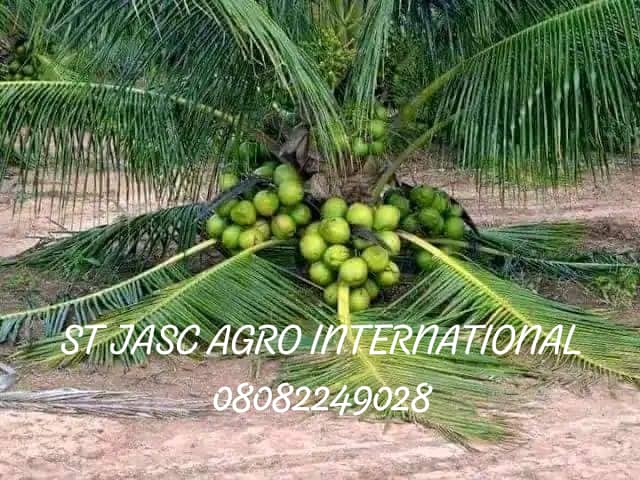ST JASC AGRO INTERNATIONAL
Call/WhatsApp 08082249028, 07055555667
The Coconut: A Comprehensive Guide to Cultivation as an Agricultural Cash Crop
Coconut cultivation is a significant agricultural practice in many tropical and subtropical regions around the world. Known for its versatility, the coconut palm (Cocos nucifera) yields products that are widely used in food, cosmetics, and industrial applications. This blog explores key aspects of coconut cultivation, including planting techniques, fertilizer applications, harvesting methods, and essential cultural practices to ensure a fruitful yield.
## Planting Techniques
### Site Selection
The first step in coconut cultivation is selecting an appropriate site. Coconuts thrive in sandy loam soils with good drainage, slightly acidic pH (between 5.0 and 7.0), and minimal salinity. The chosen site should receive full sunlight and be protected from strong winds, typically achieved by planting windbreaks like tall trees.
### Seedlings or Seed Preparation
Coconuts can be planted using mature seeds or nursery-grown seedlings. For seeds, choose mature coconuts that are at least 12 months old. The process involves:
1. **Pre-Soaking**: Immersing the seeds in water for a week helps to soften the husk and encourages germination.
2. **Germination**: Place the seeds in a shaded nursery bed with well-drained soil. Ensure they are buried half their size, keeping them moist during the germination phase, which takes about 3-7 months.
### Planting
Once the seedlings reach a height of about 1.5 feet, they can be transplanted:
1. **Spacing**: Use either triangular or square planting systems, maintaining a distance of 7-10 meters between palms for optimum growth.
2. **Holes Preparation**: Prepare plant holes that are 1 meter wide and 1 meter deep, incorporating organic matter to improve soil fertility.
3. **Planting**: Place the seedlings in the holes, ensuring that the root ball is well covered and firmed down to avoid air pockets.
## Fertilizer Applications
Proper nutrition is crucial for maximizing coconut yields. Fertilization should be done at different stages of the plant’s growth:
### Primary Nutrients
Coconuts require a balanced supply of nitrogen (N), phosphorus (P), and potassium (K). A common recommendation is:
– **Nitrogen**: 1 kg per palm per year
– **Phosphorus**: 0.5 kg per palm per year
– **Potassium**: 1 kg per palm per year
### Application Methods
1. **Basal Application**: Apply fertilizers at the base of the palm, ensuring the fertilizer is spread evenly around the root zone.
2. **Fertigation**: For mature palms, consider fertigation, where fertilizers are supplied through irrigation systems for increased efficiency.
3. **Organic Fertilizers**: Incorporating organic matter like compost, green manures, and biofertilizers improves soil structure and health.
### Timing
Fertilizers should be applied in three splits: before the monsoon, after flowering, and before the dry season, aligning with the palm’s growth and nutrient uptake periods.
## Harvesting Techniques
Harvesting coconuts requires specific methods to ensure fruit quality and labor efficiency:
### Maturity Indicators
– **Water Volume**: Mature coconuts will have a substantial amount of water inside.
– **Color**: The outer husk turns from green to yellow-brown.
– **Sound**: Mature coconuts produce a hollow sound when tapped.
### Harvesting Process
1. **Tools**: Use a sharp knife or sickle for cutting coconuts from the tree’s tuft. In taller palms, long-handled tools may be required.
2. **Safety**: Ensure safety measures are in place to avoid accidents, as falling coconuts can cause injuries.
3. **Post-Harvest**: Carefully handle coconuts to avoid damage. They should be placed in shaded areas to prevent spoilage.
## Cultural Practices in Coconut Cultivation
### Weed Management
Weeds compete with coconuts for nutrients and moisture. Manual weeding or mulching with organic matter can effectively control weed growth while enhancing soil health.
### Pest and Disease Control
Regular monitoring for pests like coconut mites, weevils, and scales is essential. Implement integrated pest management (IPM) practices, including biological controls, neem oil, and intercropping with pest-repelling plants to reduce pesticide use.
### Irrigation
Coconuts require adequate moisture, especially during dry periods. Drip irrigation or water conservation practices can ensure consistent water supply without waterlogging.
### Pruning
Regular pruning of dried leaves and inflorescences helps improve air circulation, light penetration, and overall palm health. This practice mitigates pest infestations and diseases.
### Crop Rotation and Intercropping
Integrating legumes or other cash crops alongside coconuts can improve soil fertility and reduce disease prevalence.
## Conclusion
Coconut cultivation offers immense potential as a cash crop, provided that farmers adopt proper planting techniques, fertilization practices, and cultural management strategies. With the right care, coconuts can yield bountiful harvests, supporting farmers’ livelihoods while sustaining environmental health. Establishing knowledge of these best practices can lead to successful coconut farming and contribute to the growing global demand for coconut products.
ST JASC AGRO INTERNATIONAL
Call/WhatsApp 08082249028, 07055555667



